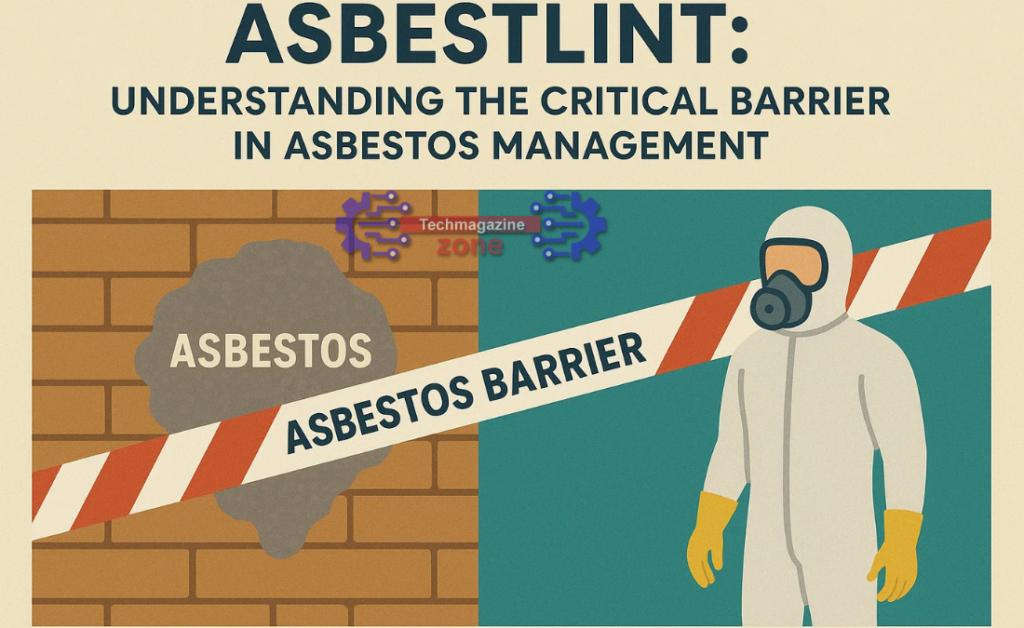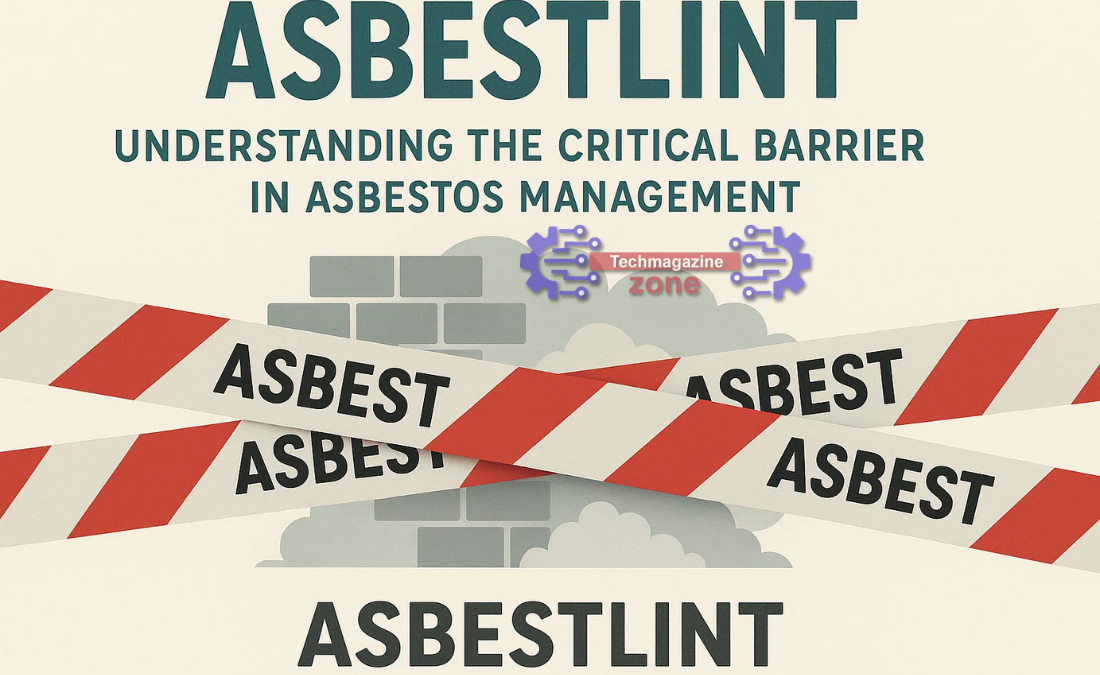The world of hazardous material management is filled with specialized terms and crucial safety protocols. Among these, the term asbestlint stands out as a word of Dutch origin that translates directly to “asbestos tape” or “asbestos sealing tape.” However, its meaning extends far beyond a simple translation. Asbestlint represents a first line of defense, a critical visual and physical barrier used to seal off and signify areas contaminated with or likely to contain asbestos fibers. While the word itself might not be common in everyday English vocabulary, the concept it embodies is a cornerstone of safety in construction, demolition, and environmental remediation industries across the globe. Understanding asbestlint is to understand a fundamental practice in preventing a silent and deadly exposure.
What Exactly is Asbestlint? Defining the Tool
Asbestlint is a highly visible, self-adhesive barrier tape, similar to police caution tape, but specifically designed for asbestos hazards. It is not made from asbestos; rather, it is used to mark the presence of asbestos. This is a crucial distinction. The tape is typically produced in a striking, standardised combination of blue and white, or red and white, colours. These colours are not arbitrary. They are chosen for high visibility and are often codified in national safety regulations to ensure instant recognition by workers, inspectors, and the public.
The tape itself is usually made from a durable, tear-resistant plastic like polyethylene or polypropylene. It must be strong enough to remain intact once deployed, creating a reliable barrier. The most important feature of asbestlint is the printed text. It will boldly display warnings such as:
- “DANGER – ASBESTOS”
- “DO NOT ENTER – ASBESTOS HAZARD”
- “CANCER AND LUNG DISEASE HAZARD”
- “AUTHORIZED PERSONNEL ONLY”
This explicit messaging removes any ambiguity. Unlike generic “Caution” tape, asbestlint leaves no room for doubt about the specific nature of the danger, ensuring that everyone, regardless of language or training level, understands the severe risk present.
The Critical Role of Asbestlint in Safety Protocols
The primary function of asbestlint is to create a clearly defined regulated area. When asbestos-containing materials (ACMs) are identified or even suspected, the first step in any safety plan is to establish a perimeter. This perimeter, sealed with asbestlint, serves multiple vital roles:
1. Demarcation and Access Control: The tape physically defines the boundary between a safe zone and a hazardous zone. It is strung across doorways, stairwells, and corridors to prevent the unintentional entry of unauthorized personnel. This includes other tradespeople, building occupants, and members of the public who could unknowingly wander into a contaminated area.
2. Visual Communication and Warning: Its bright colours and bold text provide an immediate and unambiguous warning. This visual cue is essential for preventing accidents and ensuring that anyone approaching the area is aware of the hazard before they even get close enough to require personal protective equipment (PPE).
3. Containment Support: While asbestlint is not a primary containment sealant itself (that is the role of specialized plastic sheeting and negative air pressure units), it acts as a crucial marker for the integrity of the containment. It helps seal the edges of plastic sheeting at door frames and windows, and its breach is an immediate visual indicator that the containment may be compromised.
In essence, asbestlint is the exclamation point in the language of asbestos safety. It transforms an invisible, airborne threat into a visible, manageable boundary.
Proper Deployment: How and Where to Use Asbestlint
The effectiveness of asbestlint is entirely dependent on its correct application. It is not enough to simply hang a strand of tape; it must be deployed systematically and securely as part of a comprehensive asbestos management plan.
Key Locations for Deployment:
- Entrances and Exits: All points of entry into a designated asbestos work area must be sealed with asbestlint. This is non-negotiable.
- Ventilation Systems: Openings for HVAC ducts must be taped off to prevent fibers from entering the building’s air circulation system.
- Windows and Cracks: Any potential pathway for fiber escape should be flagged and sealed.
- Perimeter of the Work Area: The tape should be used to create a continuous barrier around the entire zone, ensuring no gaps are left.
Procedure for Use:
The tape must be fixed to all walls, floors, and fixed structures, creating a complete seal. It should be applied taut and secure to prevent sagging or accidental detachment. The warning text should be clearly visible and legible from all expected angles of approach. Furthermore, the tape must only be removed by licensed asbestos abatement professionals once the area has been fully decontaminated and cleared by air monitoring.

The Consequences of Neglecting Asbestlint
The failure to properly use asbestlint is a severe safety violation with potentially devastating consequences. Asbestos fibers, when inhaled, can lead to serious diseases such as asbestosis, lung cancer, and mesothelioma—a deadly cancer of the lung lining. These diseases have long latency periods, often developing decades after exposure.
Without this critical barrier:
- Unaware Individuals are at Risk: Maintenance staff, other construction workers, or office employees could easily enter a contaminated area, stirring up fibers and exposing themselves and others.
- Cross-Contamination Occurs: Airborne fibers can migrate from the work area into clean zones on clothing, tools, or through air currents, spreading the hazard throughout a building.
- Legal and Financial Repercussions: Neglecting to mark an asbestos hazard is a breach of health and safety laws (such as OSHA in the US or the Control of Asbestos Regulations in the UK). This can result in massive fines, project shutdowns, and crippling liability lawsuits from affected individuals.
The absence of asbestlint represents a catastrophic failure in duty of care, turning a controlled abatement project into an uncontrolled public health risk.
Beyond the Tape: The Holistic Approach to Asbestos Safety
It is vital to recognize that asbestlint is just one component of a much larger safety system. It is a critical tool, but it is not a standalone solution. A proper asbestos abatement project integrates the tape with other essential measures:
- Negative Air Pressure Units: These machines create a pressure differential, ensuring air flows into the contained work area and not out, trapping fibers inside.
- Plastic Sheeting: Thick plastic is used to create physical containment walls and floors.
- Decontamination Units: These purpose-built chambers (with clean, shower, and dirty rooms) allow workers to safely enter and exit, preventing them from carrying fibers out on their person.
- Personal Protective Equipment (PPE): This includes respirators with P100 filters and disposable coveralls (often called disposable overalls) for all personnel inside the contained area.
- Worker Training: Ultimately, tools are only as effective as the people using them. Comprehensive training on the meaning, use, and importance of asbestlint and all other protocols is the true foundation of safety.
Conclusion: The Vital Line of Defense
Asbestlint is far more than just a roll of tape. It is a symbol of responsibility, a communicator of danger, and a physical guardian of public health. This simple, brightly coloured barrier embodies the core principle of asbestos management: recognition, communication, and containment. Its proper use signifies a professional and conscientious approach to dealing with one of the most pervasive and dangerous legacy hazards in the built environment. While the word itself may be Dutch, the practice it describes is a universal language of safety. In the ongoing effort to manage asbestos and protect present and future generations from its hidden threat, asbestlint remains an indispensable, non-negotiable first line of defense.
